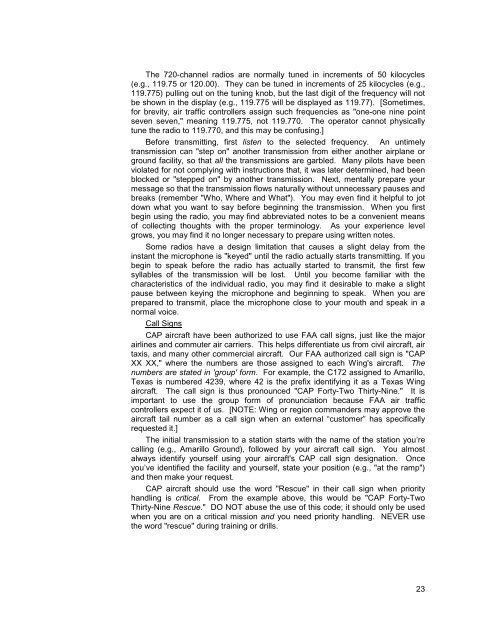MART Vol. II MO/MP - NESA - Civil Air Patrol
MART Vol. II MO/MP - NESA - Civil Air Patrol
MART Vol. II MO/MP - NESA - Civil Air Patrol
Create successful ePaper yourself
Turn your PDF publications into a flip-book with our unique Google optimized e-Paper software.
The 720-channel radios are normally tuned in increments of 50 kilocycles(e.g., 119.75 or 120.00). They can be tuned in increments of 25 kilocycles (e.g.,119.775) pulling out on the tuning knob, but the last digit of the frequency will notbe shown in the display (e.g., 119.775 will be displayed as 119.77). [Sometimes,for brevity, air traffic controllers assign such frequencies as "one-one nine pointseven seven," meaning 119.775, not 119.770. The operator cannot physicallytune the radio to 119.770, and this may be confusing.]Before transmitting, first listen to the selected frequency. An untimelytransmission can "step on" another transmission from either another airplane orground facility, so that all the transmissions are garbled. Many pilots have beenviolated for not complying with instructions that, it was later determined, had beenblocked or "stepped on" by another transmission. Next, mentally prepare yourmessage so that the transmission flows naturally without unnecessary pauses andbreaks (remember "Who, Where and What"). You may even find it helpful to jotdown what you want to say before beginning the transmission. When you firstbegin using the radio, you may find abbreviated notes to be a convenient meansof collecting thoughts with the proper terminology. As your experience levelgrows, you may find it no longer necessary to prepare using written notes.Some radios have a design limitation that causes a slight delay from theinstant the microphone is "keyed" until the radio actually starts transmitting. If youbegin to speak before the radio has actually started to transmit, the first fewsyllables of the transmission will be lost. Until you become familiar with thecharacteristics of the individual radio, you may find it desirable to make a slightpause between keying the microphone and beginning to speak. When you areprepared to transmit, place the microphone close to your mouth and speak in anormal voice.Call SignsCAP aircraft have been authorized to use FAA call signs, just like the majorairlines and commuter air carriers. This helps differentiate us from civil aircraft, airtaxis, and many other commercial aircraft. Our FAA authorized call sign is "CAPXX XX," where the numbers are those assigned to each Wing's aircraft. Thenumbers are stated in 'group' form. For example, the C172 assigned to Amarillo,Texas is numbered 4239, where 42 is the prefix identifying it as a Texas Wingaircraft. The call sign is thus pronounced "CAP Forty-Two Thirty-Nine." It isimportant to use the group form of pronunciation because FAA air trafficcontrollers expect it of us. [NOTE: Wing or region commanders may approve theaircraft tail number as a call sign when an external “customer” has specificallyrequested it.]The initial transmission to a station starts with the name of the station you’recalling (e.g., Amarillo Ground), followed by your aircraft call sign. You almostalways identify yourself using your aircraft's CAP call sign designation. Onceyou’ve identified the facility and yourself, state your position (e.g., "at the ramp")and then make your request.CAP aircraft should use the word "Rescue" in their call sign when priorityhandling is critical. From the example above, this would be "CAP Forty-TwoThirty-Nine Rescue." DO NOT abuse the use of this code; it should only be usedwhen you are on a critical mission and you need priority handling. NEVER usethe word "rescue" during training or drills.23














